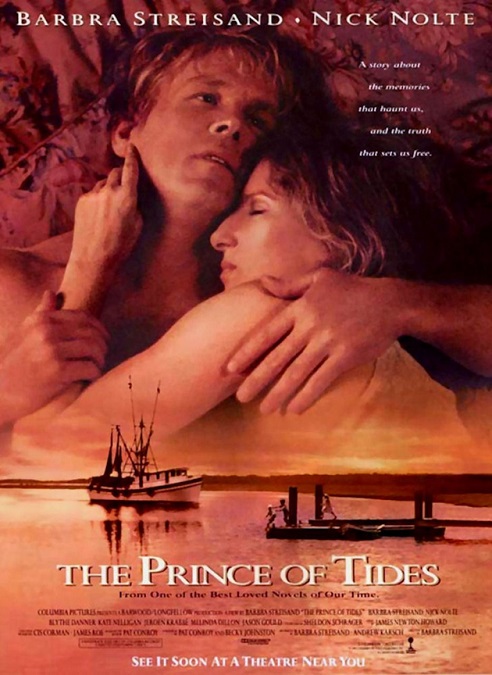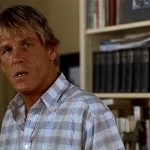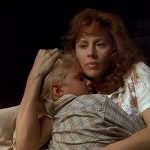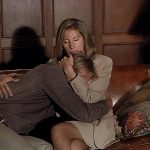
The Prince of Tides – 1991
I was really surprised by this film on more than one count. First, I have never been a fan of Nick Nolte. In my head, I have always had this unfounded, preconceived notion that the actor was just a real jerk. I don’t know why, but I have always instinctively avoided watching his films. But after watching The Prince of Tides, I think I might have an idea as to why I can’t stand him. It is because he is such a good actor.
I’ll explain. I don’t like dealing with people who are easily angered or people who, when they become angry, display anger so intense that it is almost frightening to see. Unfortunately, Nolte is an actor who can go from zero to one hundred at the drop of a hat, and his emotions seem completely real. I instinctively react to such raw emotion and become angered in response. He has a facial expression of fury that looks far too natural on him. But Nolte portrayed far more than anger. There was a full range of emotions that were fueled by a powerful story, and Nolte turned in a memorable performance.
I speak mostly about him, but I can’t ignore Barbara Streisand’s performance as his leading lady, and the movie’s director. The plot had several surprising revelations that propelled the narrative. It took place in two different locations, South Carolina and New York City. Nolte played Tom Wingo, a man whose life is on the verge of falling apart. He has no job, and his marriage seems to be floundering. He carries an unimaginable amount of emotional baggage because of a wildly dysfunctional childhood.
Tom’s twin sister Savannah’s latest suicide attempt forces Tom to reluctantly travel to New York to help her psychiatrist, Susan Lowenstein, played by Streisand, to delve into her past. As Tom and Susan try to figure out why Savannah has tried to kill herself again, Tom effectively dredges up his own ghosts. And all the while, a subtle romance begins to develop between Tom and Susan.
And that brings me to the second thing about the film that really surprised me. I loved that the film devoted just as much time to Tom and his emotional journey as it did to the romance. It was subtle and yet completely visible. As the film’s director, Streisand took her time developing the relationship between them. It was beautifully done, and when, near the final stages of the film, they finally jumped into bed, it was both expected and welcome. It was never portrayed as something tawdry or taboo. They were both married and they remained true to their marriages until it became clear that their respective spouses had moved on to other lovers.
That isn’t to say there wasn’t any flirting, but I respected Tom’s character because when Susan’s ever-traveling husband returned home, he stepped aside graciously and without apparent bitterness. He only took Susan away after her husband went out of his way to humiliate them both. When Susan asked him to take her with him, he did so without hesitating. I also liked that there were a good number of flash back sequences in the film, depicting how messed up his, and consequently Savannah’s childhoods really were. They had a brother, Luke, who had been dead for some time. Their father was both physically and emotionally abusive, treating everyone in his house with cruelty. And the mother wasn’t much better, rarely showing anything that might resemble love.
And then there was the event. During one of the flash backs, Tom tells Susan of a night when three escaped convicts invaded their home. Not only were his mother and thirteen year old Savannah raped, but Tom, himself, was also raped. But that wasn’t all. Luke came in with a shotgun and killed two of the rapists, while the mother killed the third. Then, to make the whole situation even more messed up, Mom ordered her boys to take the bodies outside and dispose of them while she and Savannah cleaned all the blood off the walls. All this was done before Dad ever got home. Then the whole thing was just ignored as if it had never happened. The scene where Susan guides Tom into dealing with his hidden emotions over the incident was powerful, and both Nolte and Streisand did such a great job with it.
Blythe Danner and Melinda Dillon did just fine as Tom’s wife, Sally, and Savannah. Though Dillon didn’t have much screen time, I will always hold a special place in my heart for her for her great performance in one of my favorite science-fiction movies, Close Encounters of the Third Kind. Susan’s son Bernard, was also a pretty important character. He was played by Streisand’s real-life son with actor Elliot Gould, Jason Gould. Bernard develops a paternal relationship with Tom, helping Tom to feel more comfortable with being a part of Susan’s life.
It was a well-crafted movie, and I have to give props to Streisand for some pretty great directing as well as some spot-on acting. But again, I have to give credit where credit is due. Nolte really did a phenomenal job. I think that maybe I need to give the actor and his extensive body of work a second chance.








